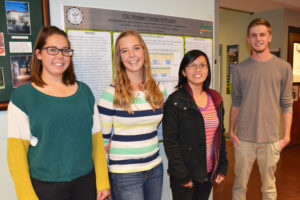
Colorado State University, the University of Virginia and other partners received a national award Oct. 15 for their paper on how to reduce the amount of nitrogen pollution produced on college and research campuses.
The universities were lauded by the Association for the Advancement of Sustainability in Higher Education in the category of Campus Sustainability Research.
The nitrogen footprint on CSU’s campus was calculated entirely by students, which set the university team apart from other partners. Jacob Kimiecik, who graduated in May, and Emily Taylor, a senior in political science, spearheaded the analysis as members of the Student Sustainability Center, housed at the School of Global Environmental Sustainability. Tim Weinmann, who is pursuing a master’s degree in ecology, and Alannah Liebert, a senior majoring in biological science, helped gather information from across campus to calculate the footprint.
“The CSU Student Sustainability Center did a remarkable job of assembling the data, checking and re-checking the numbers, and writing up the results,” said Jill Baron, faculty mentor for the project and a professor in the Department of Ecosystem Science and Sustainability.

Campus partners
This same group is now partnering with the Eco Leaders, peer-to-peer educators, within Housing & Dining Services to talk with students about how to reduce their nitrogen footprint through changes in diet — eating less meat and dairy — and transportation, including biking to school or work, or taking public transportation, according to Baron.
The award-winning paper highlights the first results of efforts to calculate the total amount of nitrogen released at CSU and the other institutions. The paper documents the steps that universities can take to reduce nitrogen pollution, a serious environmental problem related to contaminated water and public health impacts.
How serious? Baron said that parallels can be made with the impact of climate change. “Nitrogen poses a real problem to the planet,” she said. “We want to raise awareness that people can make small changes in their daily routines to minimize the damage it can cause.”

Researchers at the University of Virginia created a Nitrogen Footprint calculator for people and organizations to measure the amount of nitrogen released to the environment as a result of human activities. The CSU team used this calculator to assess nitrogen released from different sector of the university in 2014.
An institution’s nitrogen footprint represents a broad picture of campus sustainability related to how reactive nitrogen contributes to both local and global impacts on the ecosystem and human health.
“What makes the Nitrogen Footprint calculator unique among campus sustainability assessments is that it allows researchers to account for the environmental impact of food production, which is not explicitly captured in attempts to measure carbon footprints or other tools,” said lead author Elizabeth Castner at the University of Virginia. “We can also make projections and calculate scenarios for sustainability strategies and how the footprint may change with new buildings on campus, or as the student population increases.”
Major sources
CSU’s major sources of nitrogen pollution are equally distributed between food production and utilities, with smaller amounts coming from transportation. The contribution from utilities will drop dramatically as CSU fulfills its commitment to being powered by 100 percent renewable electricity by 2030.
Researchers from Brown University, Marine Biological Laboratory, Dickinson College, Eastern Mennonite University, University of New Hampshire and the U.S. Environmental Protection Agency were co-authors of the paper.
“The Nitrogen Footprint Tool Network: A Multi-Institution Program to Reduce Nitrogen Pollution,” appeared in the April issue of the journal Sustainability, which is published in collaboration with the Association for the Advancement of Sustainability in Higher Education.
The network’s efforts are sponsored by the Environmental Protection Agency’s Sustainable and Healthy Communities Research Program through a cooperative agreement with the University of Virginia. Started in 2014, the network’s agreement runs through 2019.